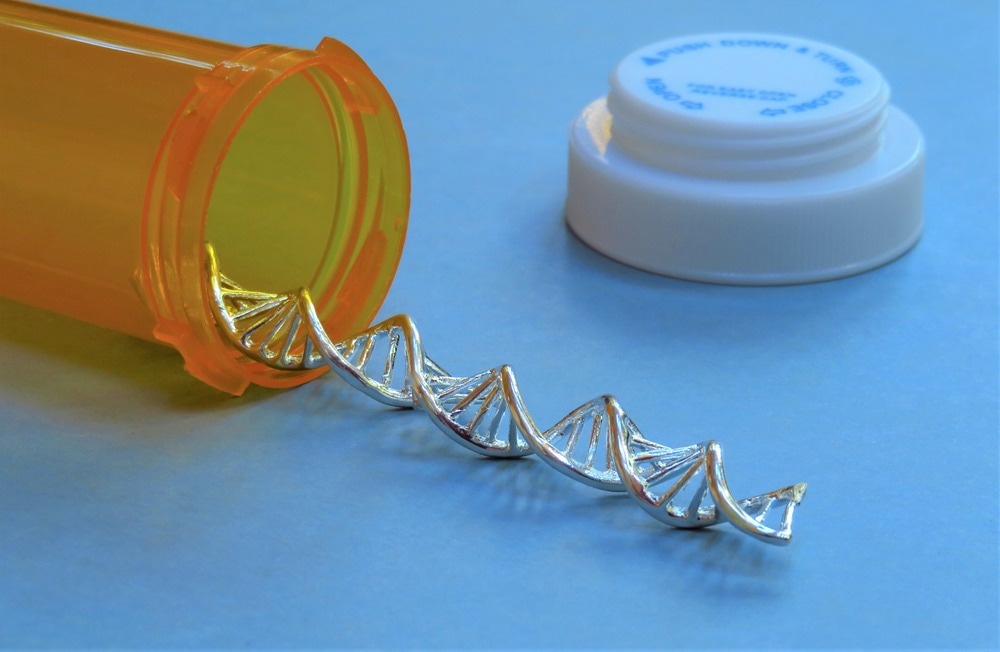By Dr. Said QabbaahReviewed by Lauren Hardaker
Since the Human Genome Project was completed in April 2003, successfully sequencing all 20,000 human genes, genomics has transformed biological science. This breakthrough paved the way for advancements in predicting, diagnosing, and treating disease, driving rapid growth in the global genomics market.

Image Credit: Prostock-studio/Shutterstock.com
Key Applications of Genomics
Genomics has contributed to a broad range of medical applications in the decades since the human genome was sequenced.
One key area is rare disease diagnosis. Genomic technologies help clinicians identify high-risk genetic mutations associated with monogenic disorders, supporting earlier and more accurate diagnoses. To date, researchers have identified over 4,000 single-gene disorders, and efforts are ongoing to expand this knowledge.
In common conditions such as high blood pressure, cancer, and diabetes, genomics is used to investigate genetic factors that may influence disease development and progression.
This is particularly relevant in pharmacogenetics, where genetic information informs drug selection and dosing, enabling clinicians to make personalized treatment decisions. Identifying genetic mutations within tumors in cancer care enables more targeted treatment approaches based on specific molecular characteristics.
Genomics has also advanced prenatal testing. Many genetic conditions can significantly impact early development and long-term health outcomes, and early detection supports informed decision-making before birth. While traditional diagnostic methods carried some risk to pregnancy, newer genomic techniques can analyze fetal DNA from a maternal blood sample, offering a safer alternative for certain types of screening.
Genomics plays a growing role in infectious diseases, particularly highlighted during the COVID-19 pandemic. Sequencing technologies are used to track the origin and spread of pathogens, identify genetic variants, and provide insights into potential treatment responses. This approach is increasingly applied to antimicrobial resistance (AMR) surveillance and the early detection of emerging zoonotic threats.
Genomic research has also contributed to the development of gene therapy, which involves modifying or replacing faulty genetic material to address the underlying cause of disease. Technologies such as CRISPR-Cas9 are based on accurately targeting specific sequences within the genome.
Lastly, genomics supports the development of precision medicine, tailoring prevention and treatment strategies based on an individual’s genetic profile. For example, genetic testing for BRCA1 and BRCA2 mutations in breast cancer can help guide targeted therapies, such as Poly (ADP-ribose) Polymerase (PARP) inhibitors, as part of a more personalized care approach.
Outside human health, genomics is expanding its footprint in areas such as agricultural biotechnology, livestock breeding, and environmental microbiome studies, supporting food security, sustainability, and climate resilience efforts.

Image Credit: Katy Pack/Shutterstock.com
Emerging Technology Trends in Genomics
The field of genomics is evolving due to ongoing technological developments. In addition to precision medicine, which has been a focus for several years, other key trends are currently influencing the field and are expected to contribute to further progress.
Artificial intelligence (AI) is transforming genomic data analysis. Machine learning algorithms can detect patterns in large datasets, helping interpret gene variants, predict disease risk, and support personalized treatment. For example, Google Health’s DeepVariant improves the accuracy of variant identification from sequencing data through machine learning.1 AI integration enhances multi-omics approaches, combining genomic, transcriptomic, proteomic, and metabolomic data for holistic disease modeling.
As CRISPR technology continues to evolve, emerging systems such as CRISPR-Cas12, CRISPR-Cas13, and base and prime editing are expanding the gene-editing toolkit. These refined techniques offer increased specificity, reduced off-target effects, and the potential to correct single-nucleotide mutations underlying many genetic disorders. Concurrently, novel delivery methods enhance the precision and safety of in vivo applications.2
Third-generation sequencing (TGS) technologies, particularly nanopore and single-molecule real-time (SMRT) sequencing, are gaining momentum for their ability to read long DNA fragments in real time. Unlike traditional short-read methods, TGS allows more accurate detection of structural variants, epigenetic changes, and full-length transcript isoforms, which are key to understanding complex genomic regions and rare diseases.3
In parallel with these advances, the Direct-to-Consumer (DTC) genomics market is shifting from ancestry testing toward health-focused applications.
New platforms offer actionable insights into disease risk, pharmacogenomics, and lifestyle traits, often integrated with digital health tools for continuous monitoring. Regulatory scrutiny is increasing, emphasizing data privacy, clinical validity, and consumer education. As a result, DTC genomics is evolving into a more regulated, hybrid model that blends consumer empowerment with clinical oversight.4 Ethical questions surrounding the commercialization of genetic data, potential discrimination, and consent transparency are gaining attention from regulators and advocacy groups.
Current Global Market of Genomics
The global genomics market was valued at approximately USD 37.94 billion in 2024 and is projected to reach USD 44.21 billion in 2025 and USD 175.18 billion by 2034, with a compound annual growth rate (CAGR) of 16.53%.5
North America leads the market, accounting for around 42.65% of the global share in 2024, with the U.S. contributing over 80%. This dominance is driven by substantial R&D investment, advanced healthcare infrastructure, and the presence of major industry players. Government initiatives, such as the National Institutes of Health's (NIH) funding for precision medicine and genome sequencing, also play an important role.5,6
Asia Pacific is the fastest-growing region, with a projected CAGR of 18.11% through 2030. Growth is driven by increased healthcare investment, rising awareness of personalized medicine, supportive government policies, and partnerships between research institutions and global biotech firms. Major contributors include China, India, Japan, and South Korea, with initiatives such as China’s “Healthy China 2030” emphasizing the role of genomics in healthcare modernization.5,6 Emerging players across Southeast Asia and the Middle East are also ramping up genomic infrastructure, signaling broader global diffusion of innovation.
Europe is also a strong player, led by the UK, Germany, and France. Its growth is supported by advanced healthcare systems, extensive research activity, and regulatory frameworks promoting genomics adoption. The EU’s “1+ Million Genomes” initiative, aiming to sequence over one million genomes by 2025, underscores the region’s focus on personalized medicine and large-scale genomic data integration. 5,7

Image Credit: Natali _ Mis/Shutterstock.com
Genomics Industry Highlights
The genomics industry has seen recent strategic activity, including high-profile mergers, innovative partnerships, and significant product launches. These moves reflect increasing collaboration to advance genomic research and personalized healthcare.
In May 2025, Regeneron Pharmaceuticals acquired 23andMe to integrate its extensive consumer genetic database into its drug discovery and development pipeline. This strategic move is expected to enhance Regeneron's ability to identify novel genetic targets and accelerate precision medicine efforts.8 Around the same time, GeneDx announced its plans to acquire Fabric Genomics, an AI-driven company specializing in genomic interpretation. The acquisition is set to strengthen GeneDx’s analytical power and scalability, enabling more efficient and accurate insights from large-scale genomic datasets.9
Other recent notable developments include Sophia Genetics collaborating with companies such as Qiagen, AstraZeneca, Memorial Sloan Kettering (MSK), NVIDIA, and Microsoft to advance genomic testing and analysis platforms.10-12 BioNTech expanded globally through 2023 partnerships in the UK and Australia to advance mRNA cancer therapies and local manufacturing, and through its 2024 acquisition of Biotheus, boosted its presence in China and next-generation oncology.13-15
In 2024, Bayer partnered with NextRNA Therapeutics to develop small-molecule cancer therapies targeting long non-coding RNAs (lncRNAs), while in early 2025, Leica Biosystems and Indica Labs launched a joint digital pathology platform to accelerate biomarker-driven diagnostics.16,17
In addition, several public-private consortia are forming to address rare disease sequencing, population health equity, and genomic-based pandemic preparedness, particularly in underserved regions.
Future Directions for Genomics
The future of genomics is being increasingly shaped by its expanding role in precision medicine and healthcare innovation. As demand grows for more accurate and individualized approaches to diagnosis and treatment, emerging technologies are propelling the field beyond sequencing and toward real-time clinical application.
One of the most promising developments in genomics is the rise of personalized cancer vaccines, which use genomic data to identify tumor-specific neoantigens and prime the immune system to target cancer cells. These vaccines depend on rapid genomic profiling and advanced bioinformatics, offering a highly tailored approach to cancer immunotherapy that has already yielded encouraging clinical trial results.18
In parallel, integrating genomics with digital twins, computational models that mirror individual patients, offers a powerful new framework for personalized healthcare. By combining genomic data with physiological, lifestyle, and environmental information, digital twins can simulate disease trajectories and predict treatment responses with remarkable accuracy, enabling proactive and optimized clinical decision-making.19
As genomic data sharing becomes more widespread, protecting privacy is an increasing concern. Federated learning has emerged as a key solution, enabling machine learning models to be trained on distributed genomic datasets without transferring sensitive data. This decentralized approach preserves patient confidentiality while facilitating collaborative research across institutions and borders.20
Beyond clinical use, genomic literacy and equitable access to testing will be essential to ensure these innovations benefit diverse populations and reduce, not exacerbate, existing health disparities.
The Road Forward
Genomics is in its third revolution, yet significant progress remains before its full potential is realized. Over the next decade, advancements are expected to broaden its clinical applications, drive targeted therapies, enhance predictive models, and enable secure, scalable, and personalized healthcare worldwide.

 Continue Reading: What does the Future Look Like for Genomics Research?
Continue Reading: What does the Future Look Like for Genomics Research?
Sources:
- Abdelwahab, O., & Torkamaneh, D. (2025). Artificial intelligence in variant calling: a review. Frontiers in Bioinformatics, 5. doi: 10.3389/fbinf.2025.1574359
- Pacesa, M., Pelea, O., & Jinek, M. (2024). Past, present, and future of CRISPR genome editing technologies. Cell, 187(5):1076-1100. doi: 10.1016/j.cell.2024.01.042
- Bianconi, I., Aschbacher, R., & Pagani, E. (2023). Current Uses and Future Perspectives of Genomic Technologies in Clinical Microbiology. Antibiotics, 12(11). doi: 10.3390/antibiotics12111580
- Jiang, S., Liberti, L., & Lebo, D. (2023). Direct-to-Consumer Genetic Testing: A Comprehensive Review. Therapeutic Innovation & Regulatory Science, 57(6):1190-1198. doi: 10.1007/s43441-023-00567-5
- Precedence Research. (2024). Genomics Market Size, Share, and Trends 2025 to 2034. [Online]. Available at: https://www.precedenceresearch.com/genomics-market (Accessed on 5 June 2025)
- Strategy & Stats (SNS) Insider. (2025). Consumer Genomics Market Size to Hit USD 10.8 Billion by 2032, Growing at a 24.6% CAGR - SNS Insider [Online]. Available at: www.globenewswire.com/.../...2-Growing-at-a-24-6-CAGR-SNS-Insider.html(Accessed on 5 June 2025)
- European Commission. (2023). 1+Million Genomes Initiative: new Roadmap is adopted for the scale-up and sustainability phase. [Online]. Available at: digital-strategy.ec.europa.eu/.../1million-genomes-initiative-new-roadmap-adopted-scale-and-sustainability-phase (Accessed on 5 June 2025)
- Sunny, M.E., & Mahatole, S. - Reuters. (2025). Regeneron to buy bankrupt 23andMe, vows ethical use of customer DNA data. [Online]. Available at: www.reuters.com/.../(Accessed on 6 June 2025)
- China Association of Clinical Laboratory Practice (CACLP). (2025). GeneDx to Acquire Fabric Genomics in Deal Potentially Worth $51M. [Online]. Available at: https://en.caclp.com/industry-news/3318.html (Accessed on 6 June 2025)
- DeMatteo, F. (2024). SOPHiA GENETICS teams up with Microsoft, NVIDIA for WGS solution. [Online]. Available at: www.investing.com/.../sophia-genetics-teams-up-with-microsoft-nvidia-for-wgs-solution-93CH-3461242(Accessed on 6 June 2025)
- Swiss Biotech. (2023). SOPHiA GENETICS: Collaboration with Memorial Sloan Kettering Cancer Center and AstraZeneca. [Online]. Available at: www.swissbiotech.org/.../(Accessed on 6 June 2025)
- Inside Precision Medicine. (2023). QIAGEN, SOPHiA GENETICS Forge NGS Analysis and Interpretation Partnership. [Online]. Available at: www.insideprecisionmedicine.com/.../ (Accessed on 6 June 2025)
- BioNTech. (2023). Press Release: BioNTech Announces Strategic Partnership with UK Government to Provide up to 10,000 Patients with Personalized mRNA Cancer Immunotherapies by 2030. [Online]. Available at: investors.biontech.de/.../biontech-announces-strategic-partnership-uk-government-provide(Accessed on 7 June 2025)
- BioNTech. (2023). Press Release: BioNTech and Australia’s State of Victoria Sign Agreement on Strategic Partnership to Strengthen mRNA Ecosystem. [Online]. Available at: investors.biontech.de/.../biontech-and-australias-state-victoria-sign-agreement-strategic (Accessed on 7 June 2025)
- BioNTech. (2025). Press Release: BioNTech Completes Acquisition of Biotheus. [Online]. Available at: investors.biontech.de/.../ (Accessed on 7 June 2025)
- BiopharmaTrend. (2024). Bayer and NextRNA Therapeutics Partner to Develop Novel Small Molecule Drugs Targeting Long Non-Coding RNA in Cancer. [Online]. Available at: www.biopharmatrend.com/.../ (Accessed on 7 June 2025)
- Leica Biosystems. (2025). Leica Biosystems and Indica Labs Announce Significant Strategic Investment and Creation of Digital Pathology Platform. [Online]. Available at: www.leicabiosystems.com/.../(Accessed on 7 June 2025)
- Hao, Q., Long, Y., Yang, Y., Deng, Y., Ding, Z., Yang, L., Shu, Y., & Xu, H. (2024). Development and Clinical Applications of Therapeutic Cancer Vaccines with Individualized and Shared Neoantigens. Vaccines, 12(7), 717. doi: 10.3390/vaccines12070717
- Li, X., Loscalzo, J., Mahmud, A.K.M.F., Aly, D.M., Rzhetsky, A., Zitnik, M., & Benson, M. (2025). Digital twins as global learning health and disease models for preventive and personalized medicine. Genome Medicine, 17, 11. doi: 10.1186/s13073-025-01435-7
- Pati, S., Kumar, S., Varma, A., Edwards, B., Lu, C., Qu, L., Wang, J.J., Lakshminarayanan, A., Wang, S., Sheller, M.J., Chang, K., Singh, P., Rubin, D.L., Kalpathy-Cramer, J., & Bakas, S. (2024). Privacy preservation for federated learning in health care. Patterns, 5(7). doi: 10.1016/j.patter.2024.100974
-
Further Reading
Last Updated: Jul 14, 2025